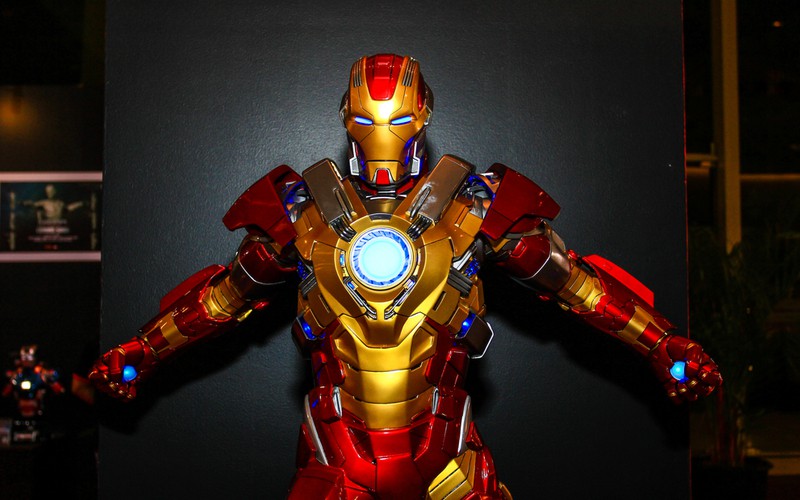With an intelligence quotient of 270, Tony Stark (Iron Man) can use technology in ways most of us could never imagine. We saw Stark’s intelligence on full display when he built the Mark I Iron Man suit during his imprisonment in Afghanistan, and that just foreshadowed things to come.
He later made improvements to the suit, and its repulsors were perhaps the most notable innovation. These allowed him to both propel himself and shoot energy blasts.
When Stark returned to the United States, he implemented repulsors into his later Iron Man suits’ palms and feet. Powered through his Arc Reactor, the repulsors converted excess electrons into muons. This created an electrical current that shot through the repulsors.
Contents
Iron Man’s Suit Explained
Tony Stark built at least 85 armored suits, though some sources point to around 93. This odyssey started with the Mark I in Iron Man and ended with the Mark LXXXV in Avengers: Endgame.
The sleek red and gold suit gave Stark an increase in speed, strength, and durability. An Arc Reactor, placed in the suit’s chest, powered it. And when you look at the suit’s hands and feet, you will notice a set of repulsors.
While many of the suits resembled one another, some carried specific capabilities. For example, the Mark I suit looked nothing like the sleeker designs that Stark rolled out later. But he had to build it while imprisoned in Afghanistan to ward off the Ten Rings.
In Age of Ultron, Stark introduced the Hulkbuster (Mark XLIV). This one was designed to match Bruce Banner (Hulk) in strength when the latter went into a random fit of rage thanks to Wanda Maximoff (Scarlet Witch).
What are Iron Man’s Repulsors?
Iron Man’s repulsors predate the Iron Man films. They were first used for the Jericho missiles, and later he applied advanced repulsor technology to the Mark II suit. This let the Mark II take and sustain flight. The Mark I suit, in comparison, only flew a short distance.
Initially, Stark built the repulsors to help him keep stable while flying and to make him quicker in a battle. They also gave him a smooth flight and allowed him to quickly change direction if needed.
He later discovered that the repulsors could fire energy blasts if he pinpointed their energy at an opponent. Stark gave the Mark III the technology to fire lethal and non-lethal blasts.
When Iron Man pursued Falcon in Captain America: Civil War, we saw him use non-lethal blasts. These blasts knocked back opponents and caused little damage.
When Stark used the lethal version, you saw the repulsors emit laser beams which were even strong enough to cut through steel and concrete.
These repulsors required ample energy demands, and thanks to Stark’s Arc Reactor, they rarely failed him.
How Does Iron Man Fire His Repulsors?
In many of Iron Man’s battles, you will notice that the repulsors in his palms became his go-to weapons. When Iron Man shot at opponents, he held out his hand and fired a beam.
What makes this technology interesting is that he was doing nothing manual. The repulsors were built-in firearms–there was no safety switch, trigger, or anything remotely identical to what you would see on a traditional firearm.
Like every feature of Tony Stark’s Iron Man suits, the repulsors channeled their energy through the Arc Reactor. The suit contained an excessive amount of electrons, and from these, Iron Man’s repulsors were ultimately able to project propulsion or energy blasts.
The process begins when these electrons convert into muons. These muons travel to the hands, feet, and chest portion of the suit in an electrical current.
This current creates plasma, and when Iron Man is ready to fire a shot, the plasma flares up, and the blast jets out of his palm.
Can Iron Man’s Repulsor Technology Exist in Real Life?
With so much technology, many Iron Man and Marvel Cinematic Universe (MCU) fans have asked if Iron Man’s repulsor technology can become a real thing in the 21st century.
The short answer to this question, unfortunately, is that we will probably never see Iron Man’s repulsor technology in real life.
But this doesn’t mean you can’t replicate some technologies, including flight. In the MCU, Stark uses technology not yet available in the real world, with one example being his ability to fly horizontally using his repulsor beams.
We saw in Iron Man that the Mark I did not use repulsor technology. Instead, if you built an Iron Man suit using compressed hydrogen fuel, you could replicate this short flight to an extent.
You wouldn’t fly horizontally. But if you ever watched anyone fly a jetpack, you would attain a similar experience.
Microjet technology also exists, and they can reach 12,000 feet in altitude. Jump jets are also a thing, and hydrogen peroxide is one way to power them.
The problem with microjets and jump jets, though, is that they won’t go mainstream for quite some time thanks to safety concerns. As technology improves, you will see them become more commonplace.
Powering an Iron Man Suit For Flight
Suppose you found an adequate fuel source to replicate the suit’s repulsor technology for flight; you would still need to power it. This has led many fans to wonder if it’s possible to build an Iron Man suit equipped with available technology and to use an Arc Reactor as a power source.
Right now, it is not possible to build anything close to an Arc Reactor to power a suit for flight.
Any type of battery in place of an Arc Reactor wouldn’t sustain flight for long either. In 2019, the University of Pennsylvania’s James Pikul pointed out that the energy density wasn’t quite there to power airplanes, let alone human armor.
Since planes rely on their wings and the wind to keep them afloat, they don’t need as much energy density as an object without wings, like an Iron Man suit.
Although the suit is much smaller than a full-sized plane, it must hover. This is where more energy density comes into play.
So, while repulsor technology and Arc Reactors are still a long way off, you can use jetpacks with hydrogen peroxide as a fuel source to sustain flight in an Iron Man-like suit. Adam Savage, best known for his time on Mythbusters, accomplished just that.
His Iron Man suit was bulletproof, and with the jetpacks, it was able to hover off the ground for a short time.

Conclusion
Iron Man’s repulsor technology gets its power from the Arc Reactor, before excess electrons convert to muons via an electrical current. This current allows Stark to propel the Iron Man suit off the ground and even use it to shoot energy blasts at opponents.
Marvel fans young and old have long been curious of whether science has advanced far enough to recreate the repulsor technology seen in the films. While we won’t see repulsors or an Arc Reactor any time soon, it is possible to create an Iron Man suit capable of flying with jetpacks.

Sion Fawkes has been covering Star Wars since January 2022, expanding his expertise in Star Wars Canon, Legends, and MCU. When not writing, you can find Sion in the gym or running trails. He also likes watching sports and listening to audiobooks.
